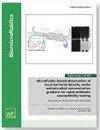Engineering models of head and neck and oral cancers on-a-chip
IF 2.4
4区 工程技术
Q2 BIOCHEMICAL RESEARCH METHODS
引用次数: 0
Abstract
Head and neck cancers (HNCs) rank as the sixth most common cancer globally and result in over 450 000 deaths annually. Despite considerable advancements in diagnostics and treatment, the 5-year survival rate for most types of HNCs remains below 50%. Poor prognoses are often attributed to tumor heterogeneity, drug resistance, and immunosuppression. These characteristics are difficult to replicate using in vitro or in vivo models, culminating in few effective approaches for early detection and therapeutic drug development. Organs-on-a-chip offer a promising avenue for studying HNCs, serving as microphysiological models that closely recapitulate the complexities of biological tissues within highly controllable microfluidic platforms. Such systems have gained interest as advanced experimental tools to investigate human pathophysiology and assess therapeutic efficacy, providing a deeper understanding of cancer pathophysiology. This review outlines current challenges and opportunities in replicating HNCs within microphysiological systems, focusing on mimicking the soft, glandular, and hard tissues of the head and neck. We further delve into the major applications of organ-on-a-chip models for HNCs, including fundamental research, drug discovery, translational approaches, and personalized medicine. This review emphasizes the integration of organs-on-a-chip into the repertoire of biological model systems available to researchers. This integration enables the exploration of unique aspects of HNCs, thereby accelerating discoveries with the potential to improve outcomes for HNC patients.头颈部和口腔癌芯片工程模型
头颈部癌症(HNC)是全球第六大常见癌症,每年导致超过 45 万人死亡。尽管在诊断和治疗方面取得了相当大的进步,但大多数类型的 HNCs 的 5 年生存率仍低于 50%。预后不良通常归因于肿瘤异质性、耐药性和免疫抑制。这些特点很难通过体外或体内模型复制,因此很少有早期检测和治疗药物开发的有效方法。芯片上器官为研究 HNCs 提供了一个前景广阔的途径,它可作为微生理模型,在高度可控的微流控平台内密切再现生物组织的复杂性。此类系统作为研究人体病理生理学和评估疗效的先进实验工具,为深入了解癌症病理生理学提供了可能。本综述概述了目前在微观生理系统中复制 HNCs 所面临的挑战和机遇,重点是模拟头颈部的软组织、腺组织和硬组织。我们进一步深入探讨了 HNCs 片上器官模型的主要应用,包括基础研究、药物发现、转化方法和个性化医疗。本综述强调将芯片上器官整合到研究人员可用的生物模型系统中。这种整合有助于探索 HNCs 的独特方面,从而加速发现有可能改善 HNC 患者预后的方法。
本文章由计算机程序翻译,如有差异,请以英文原文为准。
求助全文
约1分钟内获得全文
求助全文
来源期刊

Biomicrofluidics
生物-纳米科技
CiteScore
5.80
自引率
3.10%
发文量
68
审稿时长
1.3 months
期刊介绍:
Biomicrofluidics (BMF) is an online-only journal published by AIP Publishing to rapidly disseminate research in fundamental physicochemical mechanisms associated with microfluidic and nanofluidic phenomena. BMF also publishes research in unique microfluidic and nanofluidic techniques for diagnostic, medical, biological, pharmaceutical, environmental, and chemical applications.
BMF offers quick publication, multimedia capability, and worldwide circulation among academic, national, and industrial laboratories. With a primary focus on high-quality original research articles, BMF also organizes special sections that help explain and define specific challenges unique to the interdisciplinary field of biomicrofluidics.
Microfluidic and nanofluidic actuation (electrokinetics, acoustofluidics, optofluidics, capillary)
Liquid Biopsy (microRNA profiling, circulating tumor cell isolation, exosome isolation, circulating tumor DNA quantification)
Cell sorting, manipulation, and transfection (di/electrophoresis, magnetic beads, optical traps, electroporation)
Molecular Separation and Concentration (isotachophoresis, concentration polarization, di/electrophoresis, magnetic beads, nanoparticles)
Cell culture and analysis(single cell assays, stimuli response, stem cell transfection)
Genomic and proteomic analysis (rapid gene sequencing, DNA/protein/carbohydrate arrays)
Biosensors (immuno-assay, nucleic acid fluorescent assay, colorimetric assay, enzyme amplification, plasmonic and Raman nano-reporter, molecular beacon, FRET, aptamer, nanopore, optical fibers)
Biophysical transport and characterization (DNA, single protein, ion channel and membrane dynamics, cell motility and communication mechanisms, electrophysiology, patch clamping). Etc...
 求助内容:
求助内容: 应助结果提醒方式:
应助结果提醒方式:


